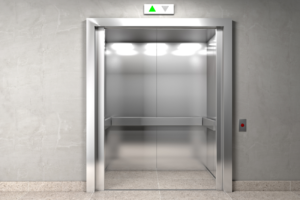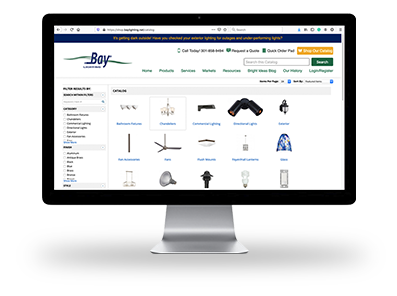Blog
- Home
- Resources
- Bright Ideas Blog
- Commercial Elevator Lighting 101
Commercial Elevator Lighting 101

Elevators are necessary for high buildings, and while people don’t spend much time in them, lighting is especially important for both safety and comfort.
Standard components of elevators include wall panels, bases, and reveals, as well as handrails and ceiling with light fixtures and emergency lighting. Because elevators have low ceilings, are a compact space, and are constantly in motion (with frequent vibrations), elevator lighting requirements are slightly different than in other areas of buildings.
Plus, most elevators are in commercial buildings, and are therefore subject to stringent electrical code requirements. Read on to understand more about basic elevator lighting principles, requirements, and types of lighting, as well as who to contact when you need an expert.
Basic Elevator Lighting Principles
There are a few basic principles to be aware of when considering proper elevator lighting:
- Safety and building codes: Elevator lighting must meet all local and state lighting regulations.
- Low to no heat emitting solutions: Elevators are small spaces, so you’ll want to alleviate as much extra heat as possible. Avoid incandescent bulbs as those produce more heat than light. LED is best due to their low to no heat emissions and cost and energy efficiency.
- Color temperature: The lighting must be comfortable for eyes. If it’s too bluish white, it can be uncomfortable, while too warm or yellow can make the interior of the elevator seem dingy. You’ll want to find somewhere in the middle.
- Efficiency: Utility costs can be high, so choose LED for lower energy/lower utility costs. You may want to consider alternative rows of light fixtures and shutting off intermittent rows of light. Additionally, keep longevity in mind – the lighting you have should be reliable and require less maintenance.
- Appearance: Elevator lighting can actually change a building’s ambiance and mood. They can’t be too dim or too bright, or too warm or too cool. They should be visually appealing as well.
- Emergency and safety lighting solutions: Elevator lights should be wired in a way so they are available in event of power outage, or they must be battery operated. Many locations are staying away from red light and instead setting emergency lights to cool white (as red is shown to induce panic and alarm).
Another consideration is that you’ll need enough lighting to be able to effectively utilize cameras for security reasons in the elevator itself. This can help protect both you and those who utilize the elevator.
Elevator Lighting Requirements
States typically have light requirements for inside an elevator, such as no more than 0.6 watts per square foot. 100 lux light level is sufficient, though in some commercial areas, 150-200 lux light level is preferred.
Elevators must be equipped with emergency lighting systems, meaning in the event of a power failure, spare lighting must be activated so passengers aren’t left in the dark. A building with four or more stories must have elevators included in a standby power system to allow elevator to operate during power outage that provide:
- At least 5 lux light levels.
- At least 1 hour of light (though can vary by state).
They also typically must turn on within a certain period of time after the outage, such as no more than 10 seconds.
The 2016 Building Energy Code also requires lighting to automatically shut off when an elevator has been unoccupied for an extended period of time (usually 15 minutes), so many take advantage of occupancy sensors or built-in elevator controls.
Types Of Elevator Lighting
Because of the compact space, recessed lights are most popular. There are three primary types of elevator lighting: Regular lamps, low voltage AC/DC fixtures, and fully integrated LED fixtures.
Regular Lamps
Because an elevator has narrow ceilings, recessed lighting can be difficult to install. So, lighting elements with a low-profile height can be a good option. You can also use LED strip lights for an even lower profile.
Converting existing or choosing LED lighting, which has a thinner body structure and is more energy efficient, can help save money and time. LED is also more resistant to vibration and motion compared to conventional systems. And due to their long life span, they will work without repair or maintenance for up to 50,000 hours.
Low Voltage AC/DC Fixtures
Recessed lighting is available in hundreds of variations, colors, color temperatures, wattages, and shapes (like square or round). 12/24VDC or 120VAC are most common, and you’d use either a GBF or 1383 lamp (Satco S29005). These offer:
- Warm white light
- 15,000 hours of light.
- Dimming options.
- Battery backup options
They are typically a single contact bayonet base or double contact bayonet base, and are damp location rated for indoor use. There are also a variety of benefits to using LED bulbs, including the fact that they don’t give off as much heat, which is ideal because elevators are small space that can easily get overheated and uncomfortable or even dangerous.
Fully Integrated LED Fixtures
LED downlights, LED spotlights, and LED panel-type lighting fixtures are common. These most often come from the elevator company. They are equipped with LED technology, which can save up to 50% energy compared to conventional lighting, with an even longer lifetime rating than screw-in LED bulbs. Plus, these are more visually appealing. Typically, these fixtures are two lighting units connected in parallel with each other; if one fails, the other can continue to perform.
Let A Lighting Specialist Help
Whether changing an existing elevator system (alterations) or installing a new lighting system, you need someone with expertise and convivence. Bay Lighting offers retrofits, system upgrades and more for your commercial and residential buildings and can help ensure your building’s elevators are properly lit. Contact us today to learn more about our lighting solutions.




